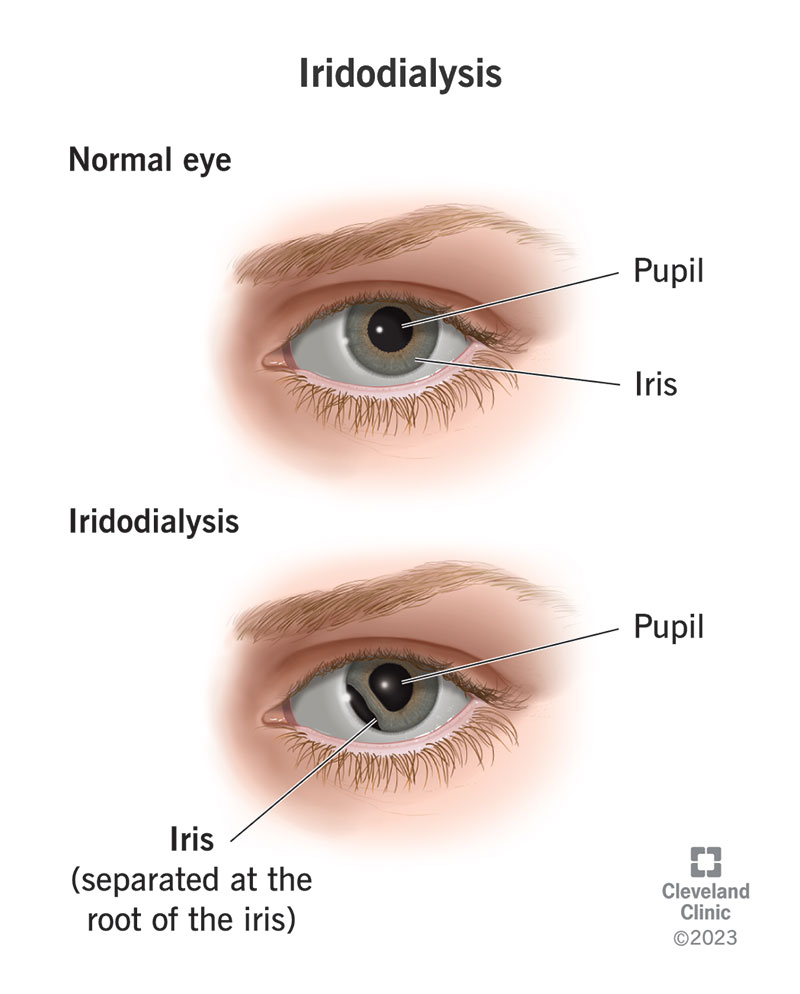Iridodialysis is the name for what happens if your iris separates from the ciliary body of your eye. It usually happens because of an eye injury. Small tears may not need treatment, but larger ones may need surgery.
Advertisement
Cleveland Clinic is a non-profit academic medical center. Advertising on our site helps support our mission. We do not endorse non-Cleveland Clinic products or services. Policy

Iridodialysis refers to the separation of the iris of your eye at the root of the iris. The root, the thinnest part, usually attaches to the ciliary body of your eye.
Advertisement
Cleveland Clinic is a non-profit academic medical center. Advertising on our site helps support our mission. We do not endorse non-Cleveland Clinic products or services. Policy
The ciliary body is a part of your inner eye. One of its functions is to make aqueous humor, a fluid that provides your eye with nutrients. The ciliary body also contains the ciliary muscle, which helps to shape your lens.
Iridodialysis typically happens because of blunt or penetrating damage from an eye injury. It may also happen during eye surgery, like cataract surgery. Iridodialysis can make it look like you have a second pupil in one eye.
You pronounce iridodialysis as “ear-id-oe-die-AL-is-is.” The plural form is iridodialyses (“ear-id-oe-die-AL-is-eez”).
Another name for iridodialysis is coredialysis, although some people may use the term coredialysis to refer to a surgical tear rather than a traumatic tear.
Eye injuries — and, therefore, iridodialyses — can happen to anyone. Injuries can happen at jobs or during sports. In older people, eye injuries can happen during falls.
Signs and symptoms of iridodialysis may include:
Iridodialysis typically happens after a penetrating or blunt eye injury. The name for this type of iridodialysis is traumatic iridodialysis. Eye injuries often happen in car accidents, work accidents or stabbings.
Advertisement
An eye care provider will be able to see that your iris has detached while performing an eye examination. They may also do an ultrasound of your eye or a CT scan (computed tomography scan). They may need to look for foreign bodies in your eye.
Your provider will use gonioscopy to check glaucoma-related drainage in your eye. Gonioscopy is a painless test that evaluates the drainage angle in your eye. The test uses a split lamp and a goniolens.
In some cases, you may not need treatment for iridodialysis.
In other cases, you may use special contact lenses to help with repair.
You may need surgery, though, if you have a large tear that causes these signs and symptoms:
Surgeons have used different types of sutures and techniques to repair iridodialysis, including lasers. Surgeons may use a newer procedure that combines implanting an intraocular lens and an artificial iris. You may have to wait until your eye heals from trauma to treat iridodialysis.
An intraocular lens is a clear implant that acts like the eye’s lens to focus light. The light comes in through your cornea and pupil and then travels back to your retina. Surgeons implant intraocular lenses to replace cloudy ones.
You can’t prevent iridodialysis completely, but you may be able to reduce your risk by protecting your eyes. One estimate says that people can prevent about 90% of all eye injuries. To do this, you can:
If you have any kind of eye trauma or injury, see a healthcare provider. You may want to ask:
Cyclodialysis refers to the ciliary body tearing away from the sclera (the white of your eye). Iridodialysis means that the iris tears away.
When the ciliary body tears away from your sclera, you may develop a type of glaucoma because the tearing disrupts the flow of aqueous humor. This fluid carries nutrients and keeps the eye inflated. When its flow is challenged, it backs up and causes the higher intraocular pressure often related to glaucoma.
Iridonesis and iridodialysis both involve the iris of your eye. But iridonesis refers to the way the iris vibrates when your eye moves. There’s no tear like there is with an iridodialysis.
Advertisement
Eye trauma can cause your iris to tear away from the ciliary body, which can create what looks like a second pupil. It’s important to get help immediately if you have an eye injury or if you notice issues after an eye surgery. Early diagnosis and treatment will give you a good chance for the best outcome.
Advertisement
Cleveland Clinic’s ophthalmologists and optometrists have the highest training available. We provide exams, vision correction and care for many eye conditions.

Last reviewed on 12/19/2023.
Learn more about the Health Library and our editorial process.